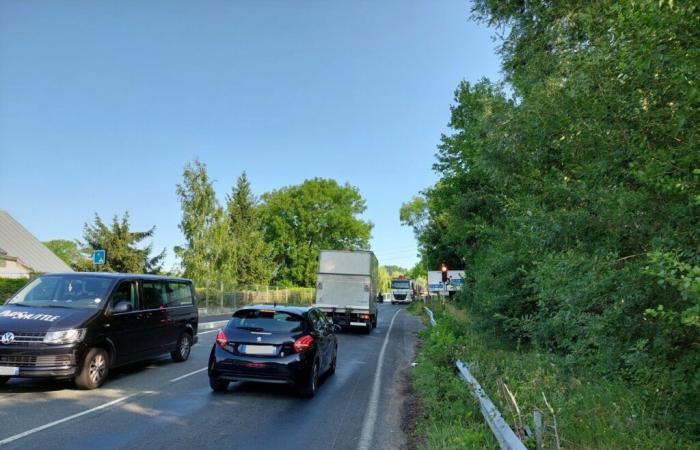
Par
Julia Gualtieri
Published on
Nov 8, 2024 at 6:50 a.m.
See my news
Follow the Marne
In the pipeline since the 1990s, the creation of a road between the D934 and the D404 would make life easier for many motorists and residents of Jablines, Lesches and Chalifert. Today, the densification of Val d'Europe makes the project even more necessary and the Department of Seine-et-Marne, pilot of the project, is aware of this. A new path is being considered.
“Until then, it was all or nothing”
“I didn’t believe it anymore, but I have a little hope again”confides Jean-Michel Barat, the mayor of Jablines. Since his election as head of this small town of less than 700 inhabitants in 1995, he has been promised the creation of a new road to connect the D934 near Chalifert and the D404 to the north of his town. Enough to relieve the village of the daily flow of vehicles, estimated at 6,000 per day, seeking to join the N3.
But for 29 years, the file has not moved forward. So where does this renewed hope come from in this disillusioned mayor? “We had a meeting about two weeks ago with the Department of Seine-et-Marne and it was envisaged to carry out this project bar by bar,” he explains. “Until then, it was all or nothing. »
A shorter route under study
When contacted, the Department was a little more reserved, but confirmed: “It’s a little premature to formulate it like that. But yes, we will work on a shorter routebetween Lesches and Jablines,” reacts Olivier Lavenka, vice-president in charge of regional planning and in particular roads. This reflection was born from two observations.
On the one hand, the fact that the Environmental Master Plan (SDRIF-E) of the Île-de-France Region, voted on September 11… did not retain the route of the deviation. “Although we suspected the result, we asked for it,” explains Olivier Lavenka.
Between 120 and 200 million euros
On the other hand, and this also explains why this route was not included in the SDRIF-E, current estimates put the realization of this deviation at a cost oscillating between 120 and 200 million eurosdepending on the assumptions. “This is an absolutely unthinkable cost currently,” comments the vice-president, if necessary.
However, it is not such a long journey. According to the hypotheses, this is achieve 7.1 to 7.7 km. In this calculation, it is in particular the construction of engineering structures which increases the bill: crossing the TGV track in certain cases, inevitable crossing of the Marne, one or more would have to be carried out. “There are also many ecological issues and certain portions could have a strong impact on local residents, requiring expropriations. This is not the case for this first potential route,” adds Olivier Lavenka.
Determine the usefulness of the deviation
For the hypothetical realization of this first section, two hypotheses are being studied. One passing to the north of the TGV track, the other to the south. In any case, implementation is all the more possible as the Department already owns the land concerned.
But before revealing too much, the Department wants advance in studies : “We must nevertheless ensure that the journey is feasible and above all useful in carrying out costing evaluations”. The cost of this section has not yet been determined.
Furthermore, evaluations carried out from mathematical models “quasi-scientific”, making it possible to evaluate the postponements, but also the increase in traffic over 15 or 20 years, must be carried out. These models also make it possible to determine the expected reduction in traffic. According to the hypotheses, this could halve traffic in the center of Chalifert et perhaps even more in the center of Jablines.
The consequences of urban development
Because the increase in traffic is very real and it is this which partly pushes the actors to move forward.
The densification of Val d'Europe has a strong impact, that is undeniable. All the construction that takes place there will cause an increase in traffic.
On a daily basis, the mayors of municipalities affected by these transit flows see this. “Traffic is increasing, that’s for sure,” says Christine Gibert, the mayor of Lesches who calls for new counts including measures on the pollution generated. “The latest studies date from 2018, but the sector has developed a lot since then. »
Traffic with multiple impacts in cities
This other small town of just over 700 inhabitants indeed attracts motorists who seek to avoid Esbly, already saturated. “They go through Trilbardou to join the N3. And conversely, when the N3 is blocked and there is an accident, we see it straight away. This situation is poisoning the lives of local residents here, but also in many communities. It's pollution, noise, annoyance and therefore incivility, disproportionate wear of the road… the consequences are numerous”, lists the mayor who is exasperated to see trucks crossing her town even though it is forbidden to the most of nine tons. “There are pedestrian protection barriers which are regularly torn down. »
“We are at the hypothesis stage”
It was partly on his initiative that the last meeting was organized. With the upcoming arrival of the new marina district in Coupvray, she is worried about the repercussions that 263 housing units planned lead to an increase in traffic. If she is delighted with this new hypothesis, she warns: “We must not see things other than as they are. We are at the hypothesis stage, everything remains to be done.”
A proposal expected in 2025
“We will come back with proposals within five to six months,” says Olivier Lavenka. The appointment is made. “The president is in favor of continuing the reflection and we will then also have to work with the intercommunal authorities concerned. We will need everyone to stand together. »
In the meantime, a new working meeting will take place in November and the mayors who are victims of trafficking, for their part, continue to take measures to try to deter motorists to make the crossing. “We are considering limiting the speed to 30 km/h and we have made an appointment with the roads agency and the gendarmerie to see together what would be appropriate to do,” explains Christine Gibert.
Follow all the news from your favorite cities and media by subscribing to Mon Actu.





